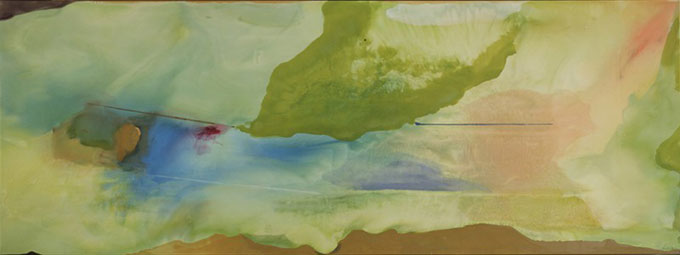Next story: Cinderella in one paragraph
Helen Frankenthaler and Paul Feeley works on display at AKAG
by Jack Foran


Leaving Marks
Two beautiful interrelated exhibits at the Albright-Knox Art Gallery present paintings of seminal transformative abstract expressionist artist Helen Frankenthaler from her career crucial decades the 1960s and 1970s, and paintings and sculptures of her art teacher in college, abstract unexpressionist Paul Feeley. Or expressionist early on, but then venturing into much older and newer realms.
Wall explanatory text on Feeley says that as a teacher he embraced the whole history of art, from Ancient Greece to the present. But as a practicing artist as well. And even pre-ancient Greece. His works bear copious and continuous reference to Cycladic sculpture from the Aegean islands off mainland Greece, from twenty centuries or so before the time of Socrates and Sophocles. More than to the art of any other time or place.
Feeley did more painting than sculpture, but his painting toward the end of his life—he died young, age 56, in 1966—was becoming more complex, more multi-dimensional, so to speak, including explicitly three-dimensional. From the early 1960s are two paintings pierced with a large oval hole in the center of the canvas, emphatically busting through picture plane two-dimensionality. And from 1965, an iconic pillar, cross-section-constructed—to create three-dimensionality, and so the piece can stand upright—of matching undulative wooden panel pieces painted in Italian flag colors, bright red and white and green. So reminiscent of undulative abstract Cycladic human figural sculptures, but going them one or two better on the abstraction score, in the non-figural—but suggestive of specifically Cycladic figural—character, and in the flat panel structural materials comically constructed into functional three-dimensionality.

The paintings—abstractions by way of formal simplification—suggest giant puzzle pieces, x-rays of unidentified innards, hair follicles. But often also with Greek and Roman references.Classical art remade, revitalized, with a tonic shot of modern. A painting from 1958 called Melos—the name of one of the Cycladic islands—looks like a row of Roman arches, evoking De Chirico, and with a Rothkovian numinous quality. A work called Caligula looks rather like intestines, and is vaguely reminiscent of the Laocoön statue.
Later works experiment with totem forms and patterns—a characteristic bone form, thin in the middle and enlarged on each end--arranged in shamanic patterns, culminating in a few sculptural works in similar mode, before the artist’s early demise. You can’t help wondering where he was heading.

Helen Frankenthaler’s exhibit has the intriguing title “Giving up one’s mark.” It refers to getting beyond the Jackson Pollock frenetic gestural mark-making dominant approach to the creation of abstract expressionist art in and around the 1950s. Frankenthaler’s alternative to gestural consisted of pour and stain application of watery paints to unprimed canvas, allowing the paint to imbue the canvas, emphasizing the physical material quality of the art means (by and large something lovely to behold and contemplate), deemphasizing the ego of the artist (by and large unlovely to behold and contemplate). The full story of the exhibit seems to be about giving up the mark in the 1950s, but then gradually, unobtrusively, as it were, without fanfare, reintroducing the mark in the 1960s and 1970s, in more active manipulation of the paint on the canvas—versus pour and stain—and imposed regular straight lines, usually horizontal, evoking a natural horizon, and so landscape, and irregular scratch lines, evoking an active artist. Minimalist mark-making in comparison with the mainstream practice.
Some spectacularly beautiful works in the show, including two epic enormous paintings in the northside main gallery, both from 1973. One in shades and layers of dominant blue, evoking weather, sky, the separation of the waters at creation, and one harder to interpret, in dominant greens and green-blue. In the same room also some smaller, more intimate works, including one in watermelon colors.
And in the adjoining galleries, variations on the theme of back and forth between equal impulses—it seems—towards pour and stain and maker’s mark. Issues of control. With titles like The Human Edge (1967) and New Paths (1973).
Included are several films/videos on Frankenthaler’s life and artistic career, with segments on the actual artmaking. You get to watch her make paintings on canvas spread out on the floor, a method she learned from Pollock. Less energetically than Pollock, but more deliberately, it looks like. And sit in on a dinner with friends and fellow artists on the occasion of a show opening. Listen in on art talk between her and artist friend Friedel Dzubas, with whom she shared studio space when they were both starting out in the early 1950s. Helen Frankenthaler died in 2011.
Both exhibits—Feeley and Frankenthaler—continue through February 15.
blog comments powered by Disqus|
Issue Navigation> Issue Index > v13n49 (Week of Thursday, December 4) > Helen Frankenthaler and Paul Feeley works on display at AKAG This Week's Issue • Artvoice Daily • Artvoice TV • Events Calendar • Classifieds |









 Current Issue
Current Issue